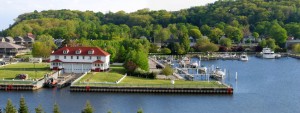
History
Elizabeth Lane Oliver Center for the Arts, formerly Crystal Lake Art Center, has been a cultural cornerstone of Benzie County since it was founded in 1948. It has moved buildings three times in its history to accommodate growth, serve all patrons, and ensure delivery on its mission to “establish and maintain an educational program and facility for the advancement of the arts, and to promote and develop visual, performing, culinary, and literary arts.” Under strong leadership of an active and experienced Board of Directors, the Center rebranded as the Elizabeth Lane Oliver Center for the Arts in 2011 and defined an ambitious Strategic Plan with facilitation by Rotary Charities Northsky Nonprofit Network.
After a capital campaign involving 331 individual donors that totaled over 3.4 million dollars, the Center established itself in the newly renovated U.S. Coast Guard Station at the mouth of the Betsie Bay, Frankfort, in 2011, where three floors present two exhibition galleries, three spacious classrooms, a demonstration kitchen, office space, storage and artwork preparation space, an outdoor deck, and ceramics studio space, all of which are accessible to people with disabilities.
The Elizabeth Lane Oliver Center for the Arts facilities were awarded LEED “platinum” certification, the highest possible, in 2013, as well as Michigan Historic Preservation Network’s 2014 “Building Award.”
United States Coast Guard Station Frankfort
The Coast Guard building dates to 1934 and was rehabilitated and restored along plans drawn up by Mike Quinn and Ann Dilcher of Quinn Evans Architects. QEA’s design prioritized historic preservation and the highest standards in sustainable construction.
The Oliver Art Center and City of Frankfort worked together to prioritize restoration and repurposing of the United States Coast Guard Station because of its unique geographical situation and historical significance. The restored building resulted from collaboration between the Oliver Art Center’s Board of Directors and Staff, Frankfort’s City Council and City Superintendent Josh Mills, the State Historic Preservation Office (SHPO), and the National Parks System.
To view Michigan Municipal League’s coverage of Oliver Art Center’s changes, please click here.
To view MML’s “placemaking” article in July 2014 edition of The Review Magazine click here.
Leadership in Energy & Environmental Design “Platinum” Certification
 The newly renovated former Coast Guard Station that houses the Elizabeth Lane Oliver Center for the Arts was given a LEED Platinum rating, the highest
The newly renovated former Coast Guard Station that houses the Elizabeth Lane Oliver Center for the Arts was given a LEED Platinum rating, the highest  “green” certificate possible, by the USGBC (United States Green Building Council). The Oliver Art Center is the 12th building in Michigan to achieve this feat, and the first in northern Michigan. This rating places a treasure of Frankfort’s history and future cultural profile in a premier class nationwide.
“green” certificate possible, by the USGBC (United States Green Building Council). The Oliver Art Center is the 12th building in Michigan to achieve this feat, and the first in northern Michigan. This rating places a treasure of Frankfort’s history and future cultural profile in a premier class nationwide.
In total the building achieved 52 points for features such as: 95% of existing walls, floors and roof are reused from the old building; the building is “super-insulated” and climate-controlled using geothermal cooling and energy recovery ventilation systems; electronic room monitoring for heating/cooling and motion-sensitive lights are used; daylight and windows were provided in all rooms; high efficiency lighting was installed everywhere, including the exhibition spaces; regionally sourced doors, windows, steel, concrete, insulation, as well as recycled materials like timber were extensively used; low flow water fixtures were installed; the property has storm water management and a permeable parking lot.
Architect Mike Quinn of Quinn Evans Architecture said that “This effort will pay for itself over the years in reduced utility costs compared to typical new construction.” Quinn went on to say “The City of Frankfort, as owner, should also take pride in this accomplishment as a demonstration of how individuals and government agencies can support creating a healthier environment for future generations.”
So impressive is the Oliver Art Center that Quinn Evans Architecture would like to submit the project over the next year for awards and recognition from peers. “We are confident” said Quinn, “the project is worthy as an important success story in terms of community cultural enrichment, design excellence, preservation of an important historic resource, and as an example of forward thinking sustainable design practices.”
Construction Management of this project was provided by 45th Parallel Construction Management.
